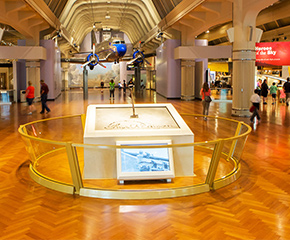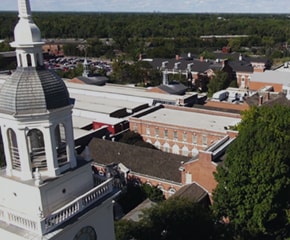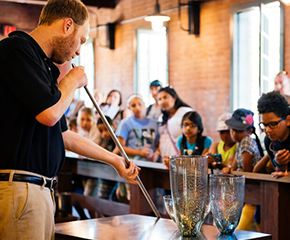The Chair in Which Abraham Lincoln was Shot, Photographed in 1865
Add to SetSummary
President Abraham Lincoln happened to be sitting in this rocking chair when he was mortally wounded at Ford's Theatre in Washington, D.C., on the evening of April 14, 1865. Mathew B. Brady made the photograph for his Brady's National Portrait Gallery. At a time before television and internet news, this carte-de-visite helped people visualize events surrounding President Lincoln's death. …
President Abraham Lincoln happened to be sitting in this rocking chair when he was mortally wounded at Ford's Theatre in Washington, D.C., on the evening of April 14, 1865. Mathew B. Brady made the photograph for his Brady's National Portrait Gallery. At a time before television and internet news, this carte-de-visite helped people visualize events surrounding President Lincoln's death.
Abraham Lincoln happened to be sitting in this rocking chair when he was mortally wounded at Ford's Theatre in Washington, D.C. on the evening of April 14, 1865. Mathew B. Brady made the original glass plate negative for his Brady's National Portrait Gallery. Brady transferred many negatives to the photographic supply firm of E. & H. T. Anthony Company of New York, N.Y. to pay the debts he owed to this supplier. The Anthony Company published this carte-de-visite photograph in 1865. At a time before television and internet news, this photograph helped people visualize events surrounding President Lincoln's death. The Lincoln assassination rocker is in the collections of The Henry Ford (ID 29.1451.1).
A successful photographer since 1841, Mathew B. Brady owned studios in Washington and New York City and became renowned for portraits of notable personalities of the time. Starting in 1861 he had the ambitious goal of documenting all aspects of the Civil War. To do this he hired many photographers to work in his studios and in the field to capture images of battles, life on the front, and important military figures. As was the custom, Brady did not identify individual photographers working for his company. However, many went on to become successful photographers in their own right, such as Alexander Gardner and Timothy O'Sullivan. Brady's vision and longevity created photographs that are meaningful records of this important time in United States history.
Carte-de-visite, French for visiting card, was a type of small photographic print on cardboard stock that professional photographers made in the nineteenth century. Popularized by the French photographer, André Disdéri in 1854, this format measured about 4 x 2.5 inches--the same size as personal calling cards of that era. Photographers made a single glass negative and then produced multiple positive prints on paper and mounted them on the cards. The backs often carried advertisements for the photographer. When mailed in the United States between 1864 and 1866, the CdVs had a tax stamp on the back. This was a source of Federal government revenue to pay for the Civil War expenses. Popular in the United States from the 1860s through the 1880s, photographers continued to offer this size into the early 1900s. After having their portraits taken at the photographer's studio, people exchanged them among family and friends. As a favorite hobby, many people gathered CdVs into photograph albums to help them remember family and celebrities.
Artifact
Carte-de-visite (Card photograph)
Date Made
1865
Subject Date
1865
Creators
Brady National Photographic Art Gallery (Washington, D.C.)
Brady, Mathew B., approximately 1823-1896
Place of Creation
United States, New York, New York
United States, District of Columbia, Washington
Creator Notes
Original negative from Brady's National Portrait Gallery, Washington, published by E. & H.T. Anthony, New York, New York.
Keywords
United States, District of Columbia, Washington
Cartes-de-visite (Card photographs)
Collection Title
On Exhibit
By Request in the Benson Ford Research Center
Object ID
71.36.3
Credit
From the Collections of The Henry Ford.
Material
Cardboard
Paper (Fiber product)
Technique
Albumen process
Mounting
Color
Black-and-white (Colors)
Dimensions
Height: 4 in
Width: 2.438 in
Inscriptions
Printed on front below image: Entered according to Act of Congress in the year 1865 by M.B. Brady in the Clerk's Office of the District Court of the U.S. for the So. District of New York. Printed on back: Published by / E. & H.T. ANTHONY / 501 Broadway / New York / FROM / PHOTOGRAPHIC NEGATIVE / in / BRADY'S / National Portrait Gallery Handwritten in ink on back: 99-ADM Handwritten in red ink on back: 202b





